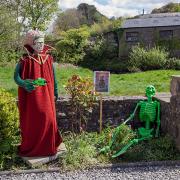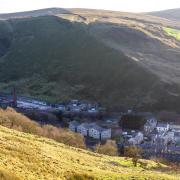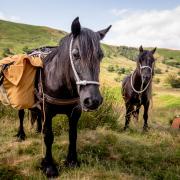Gordon Wilkinson paints the pretty Lancashire village of Rainford, a community shaped by the land. Roger Borrell unravels the history
THE roots of Rainford run deep in the dark, fertile soil which surrounds this pretty Lancashire village. It's a past inextricably linked to the land which has provided an income for generations in this lively community, wedged between Ormskirk and St Helens.
Records from 1541 mention the existence of a chapel, part of the once large Parish of Prescot. Over the years an agricultural community clustered there and then flourished as the surrounding moss land in the valley was reclaimed from the marshes.
Most were tenant farmers in the 18th century and their landlords were the powerful Molyneux family and the Earl of Derby's clan - a pub in Rainford still bears their name.
By the middle of that century almost 50 per cent of the population was dependent on agriculture for putting bread on the table.
'It wasn't just the land which formed Rainford's history but what was under that land,' says local historian Ron Dagnall.
For the next chapter in the village's history belonged to the potters, who used the copious quantities of clay found locally to start a cottage industry.
Shards from their coarse-glazed domestic pots can still be found around in the surrounding fields - a remnant of what was probably a winter activity by farming folk. An old will from Ormskirk bequeaths a relative his collection of 'Rainford mugs.'
Sir Walter Raleigh's fateful decision to bring tobacco back to the British Isles was responsible for the next boom - clay pipes.
Once the evil weed made it way out of London, enterprising Rainford artisans decided to exploit the demand and they made clay pipes by the million. Many were exported as far as Australia. The locality boasted 30 shops making pipes and, incredibly, it's a trade which didn't die out until the mid 1950s.
Coalmining was the next resource to spring from the ground with four or five pits producing fuel, most notably the Victoria Colliery.
Flooding and the national strike put paid to much of the industry but the last mine continued until 1952. But the land wasn't finished. The Pilkington glass company's voracious appetite for sand brought them to Now, there isn't really a dominant industry,' says Rob, who spent 40 years with his family building firm before retiring as a director of the company.
In fact, Rainford has come full circle with large-scale farms dominating the outskirts. They do business with some of Britain's top supermarkets by providing veg and salad crops. One even boasts of its links with a large store group via a sign at the farm gate.
The population of Rainford was just over 3,300 back in 1901 and it's now thought to have increased by around 10,000.
As it has grown so has the infrastructure and there is a busy parade of shops, five pubs and the small independent George Wright Brewery on the outskirts.
The centre is dominated by the towering All Saints Church, which dates from 1878, with its striking lych-gate.
Amid the modern clutter, there are many examples of fine architecture. Among them are the old council offices, known as the village hall, which are celebrating their 100th anniversary. Further down the road is another of the village's focal points - the library, celebrating 50 years of service.
While Rainford is now largely a place for commuters to live, it still has all the components that make up a vibrant community - the scouts and guides, the championshipwinning silver band, the Rainford High Technology College and a clutch of primary schools, the horticultural society and even an archery club. Happily, it also has a sub-Post Office which re-opened after local people campaigned for it to be revived.
While Ron Dagnall focuses on the history of Rainford, his wife Joan concentrates on its people. She is a prominent local genealogist. 'Ron was researching his family history and I asked him to do mine,' she says. 'And he said "Do it yourself!" So I did. I'm not just interested in family trees, but the branches and the twigs.'
Joan has helped many people around the world with Rainford roots to reveal their ancestors. 'It's a bit like detective work,' says Joan, who had a career running school catering.
'People are very reliant on the internet but it often contains errors. By all means start off on the net but my advice would always to be check it out. That means digging in wills and parish records.'
Joan and Ron's roots are Rainford through and through. In fact, Joan was born in the family home a few yards away from their current house in Old Lane. She started working for the family business as a milk girl at the age of five. She would be out with her father at the crack of dawn dashing up garden paths with milk jugs for customers.
Today's social workers would have a fit!


























